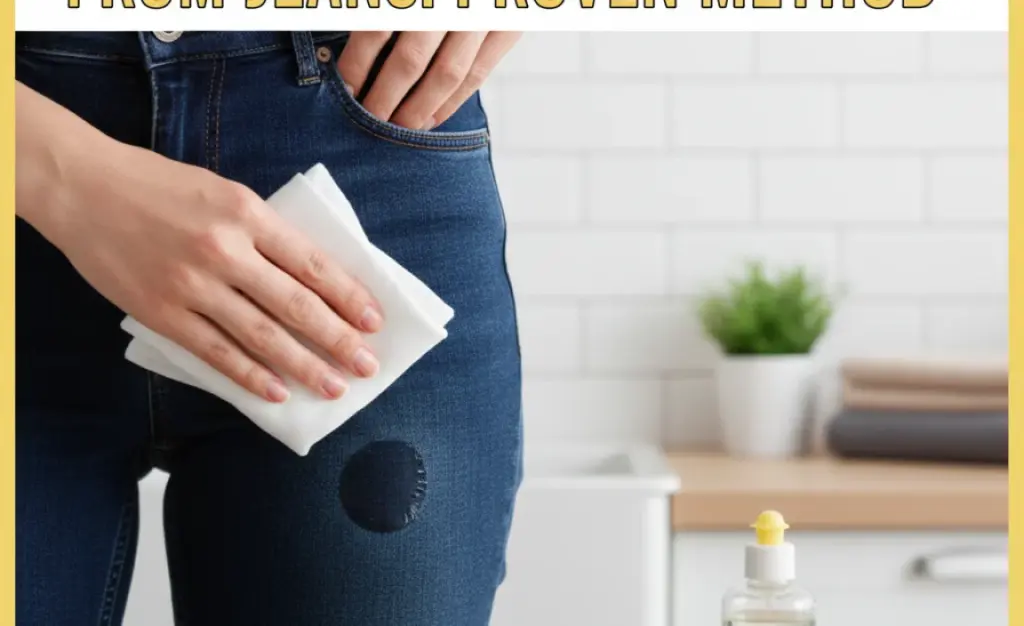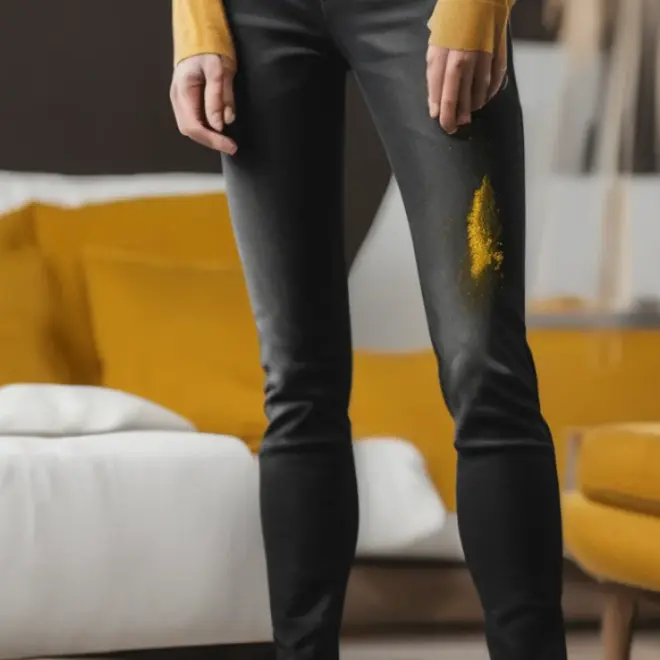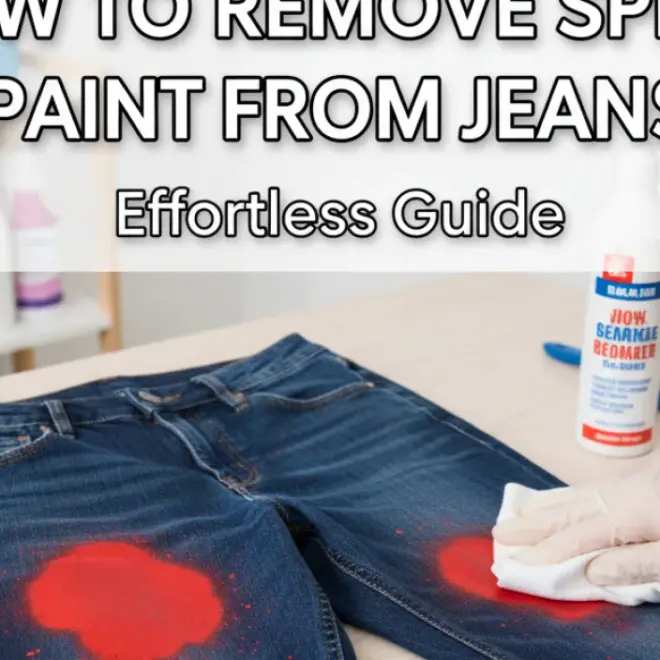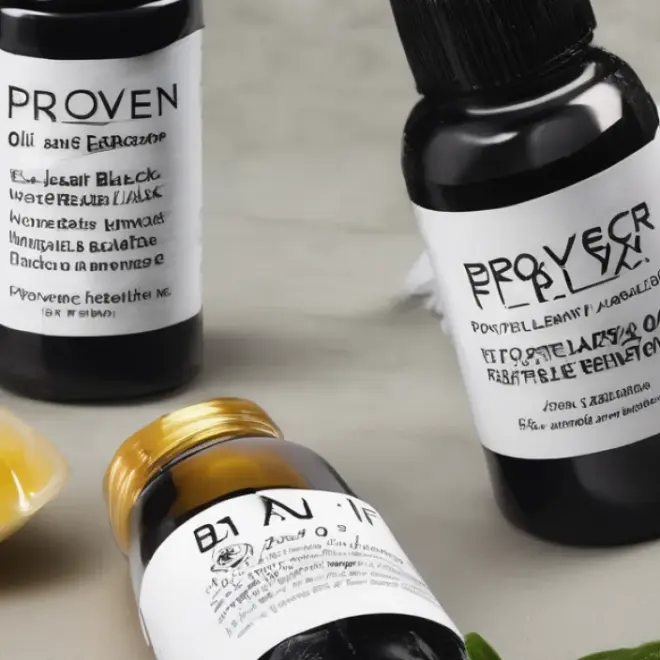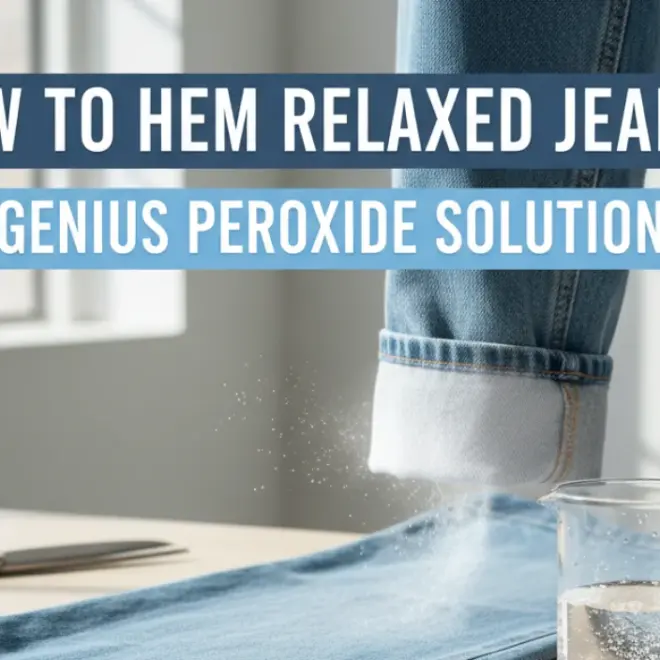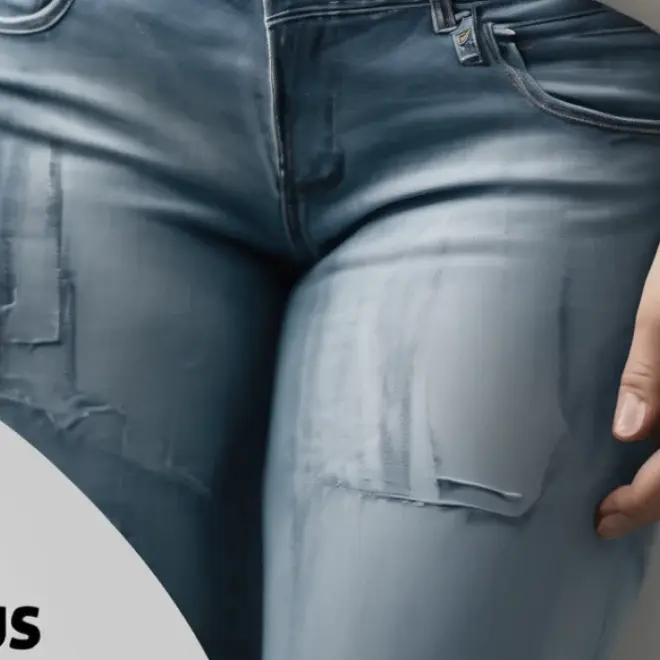Quick Summary: To remove olive oil from jeans, act fast! Blot excess oil, apply baking soda or cornstarch to absorb, let it sit, then wash as usual. For tough stains, pre-treat with a grease-cutting dish soap before washing.
How to Remove Olive Oil From Jeans: A Proven Method

Spilled a bit of salad dressing or dropped some pesto on your favorite jeans? Don’t panic! Olive oil stains are incredibly common, especially in the kitchen or at casual get-togethers. These greasy marks can seem stubborn, but with the right approach and a little patience, you can save your denim from lasting discoloration. This guide will walk you through simple, effective steps using common household items to get your jeans looking as good as new.
We’ll cover everything from immediate blotting techniques to tackling tougher, set-in stains. You’ll learn which ingredients work best and how to use them safely on your jeans. By the end of this article, you’ll have the confidence and knowledge to banish those oily marks for good, ensuring your denim remains a staple in your wardrobe.
Let’s dive into how to make those olive oil stains disappear!
Why Olive Oil Stains Are Tricky (and How to Beat Them)
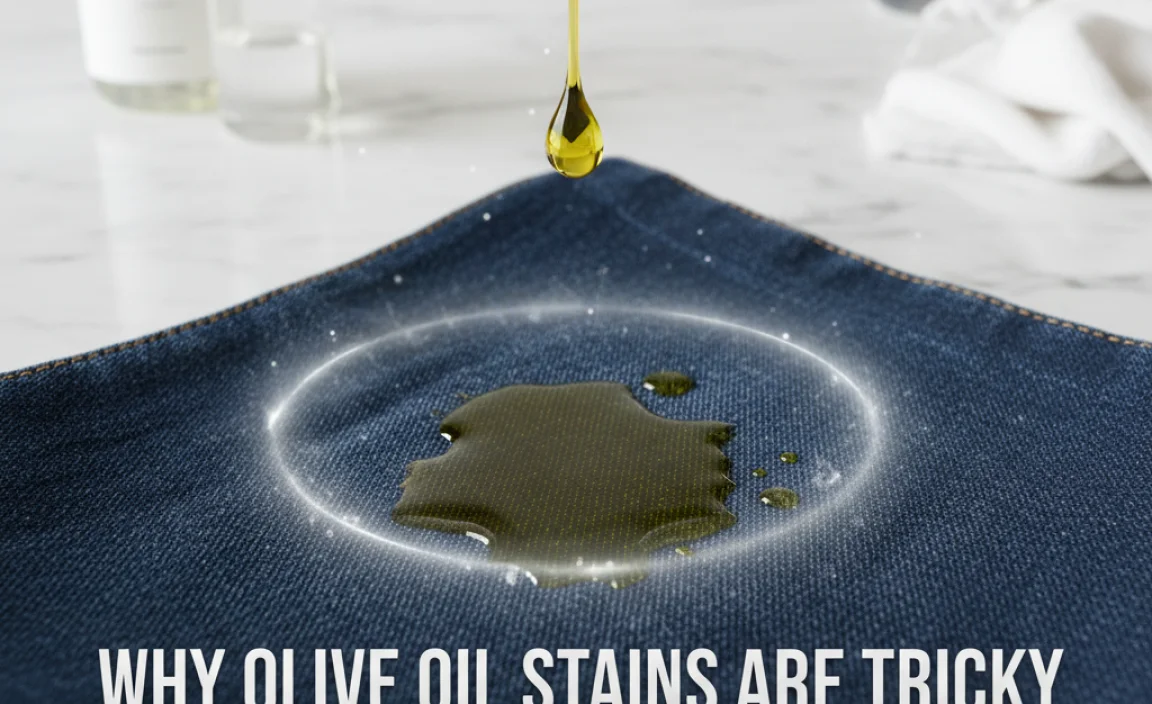
Olive oil, like other cooking oils, is a hydrophobic substance. This means it doesn’t mix well with water, which is why simply rinsing a fresh stain with water often just spreads it around. The oil molecules cling to the fabric fibers, creating a dark, often translucent spot. If left untreated, especially when exposed to heat (like in a dryer), the oil can “set,” making it much harder to remove.
The key is to break down the oil and lift it from the fabric. Fortunately, most kitchens are stocked with items that can do just that. We’ll explore the power of absorbents and degreasers to tackle this common laundry woe.
Immediate Action: The First Line of Defense
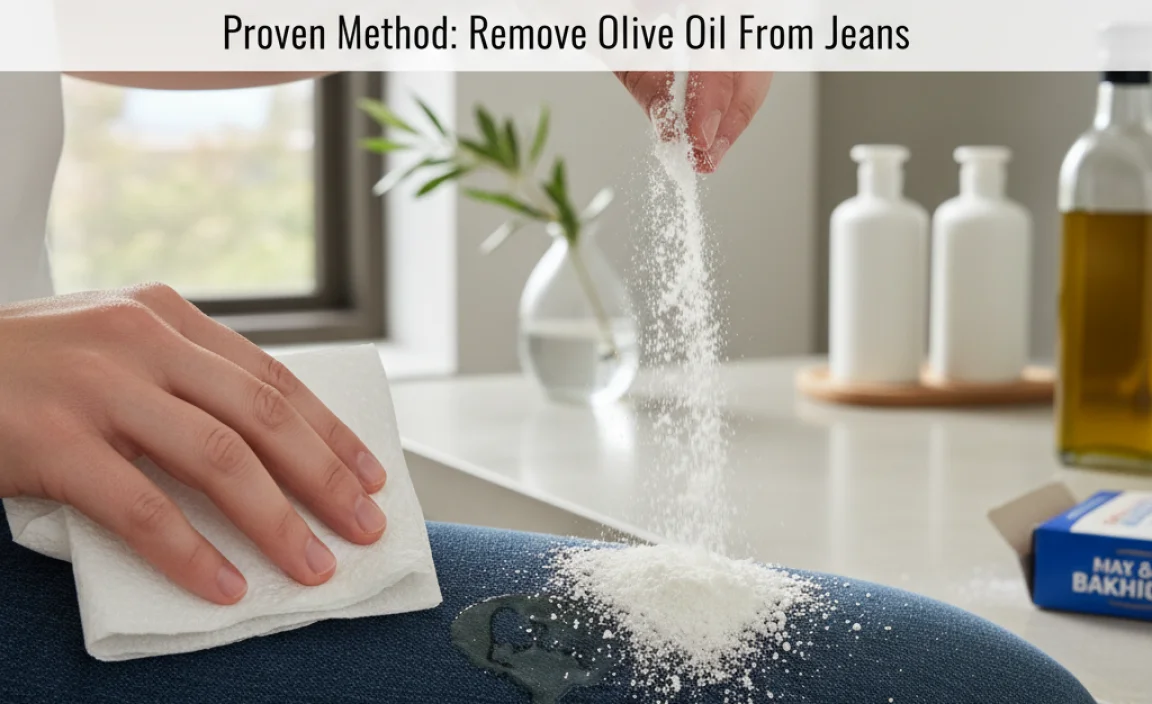
The sooner you address an olive oil stain, the easier it will be to remove. Speed is your ally here. What you do in the first few minutes can make a significant difference.
Step 1: Blot, Don’t Rub!
Your first instinct might be to rub the stain. Resist this urge! Rubbing can push the oil deeper into the fabric fibers and spread the stain, making it larger and more difficult to treat. Instead, grab a clean, absorbent material and gently blot the affected area.
- Use a paper towel, a clean dishcloth, or even a corner of a paper napkin.
- Gently press the material onto the stain.
- Replace the blotting material as it absorbs the oil. Continue until you’ve removed as much excess oil as possible.
Step 2: Absorb the Remaining Oil
After blotting, there will still be oil residue. This is where absorbent powders come in. These common kitchen staples work by drawing out the remaining oil from the fabric.
Tools You’ll Need:
- Baking soda
- Cornstarch (or talcum powder)
- A spoon or fork
- A soft brush (like an old toothbrush)
How to Apply Absorbents:
- Generously sprinkle baking soda or cornstarch directly onto the oily spot. You want to cover the entire stain area completely.
- Let the powder sit for at least 30 minutes. For tougher or older stains, you can leave it for a few hours or even overnight. The longer it sits, the more oil it will absorb.
- Once the time is up, gently brush off the powder. You might see that the powder has clumped or changed color as it absorbed the oil. This is a good sign!
This absorbent step is crucial for preventing the oil from setting into the denim during the washing process.
Tackling Tougher Stains: Degreasing Power
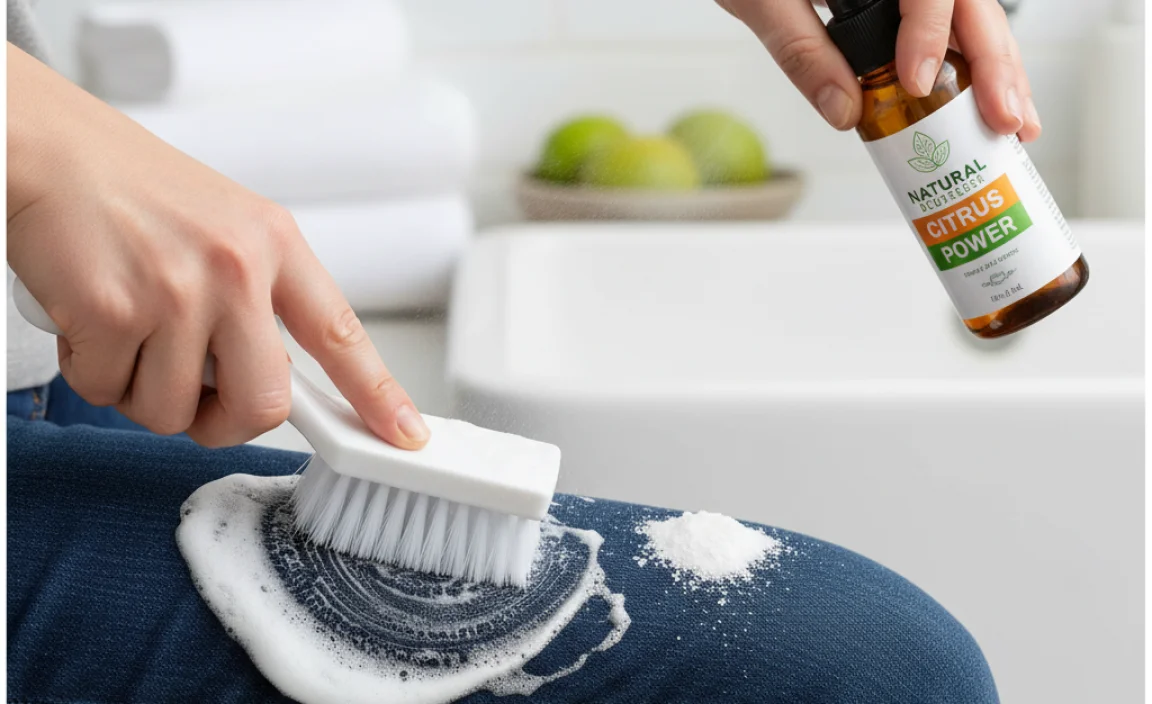
If the absorbent powder didn’t completely remove the stain, or if the stain is already dry or has been through the wash once, you’ll need a degreaser. The good news is, you probably have an effective one in your kitchen sink.
Step 3: Pre-Treat with a Degreasing Agent
Grease-cutting dish soaps are designed to break down oils and fats, making them excellent for pre-treating fabric stains. Look for a soap that specifically mentions “grease-cutting” on its label.
Recommended Degreasers:
- Dawn Dish Soap (often cited for its excellent grease-cutting abilities)
- Other popular brands with grease-cutting formulas
How to Pre-Treat:
- Apply a small amount of the grease-cutting dish soap directly onto the remaining stain.
- Gently rub the soap into the fabric with your fingers. You can also use a soft brush (like an old toothbrush) to work the soap into the fibers, but be gentle to avoid damaging the denim.
- Let the dish soap sit on the stain for about 10-15 minutes. This gives it time to start breaking down the oil.
Some users even find success by mixing a small amount of dish soap with baking soda to create a paste. Apply the paste, let it sit, and then brush off before proceeding to the wash.
The Washing Stage: Washing Your Jeans Correctly
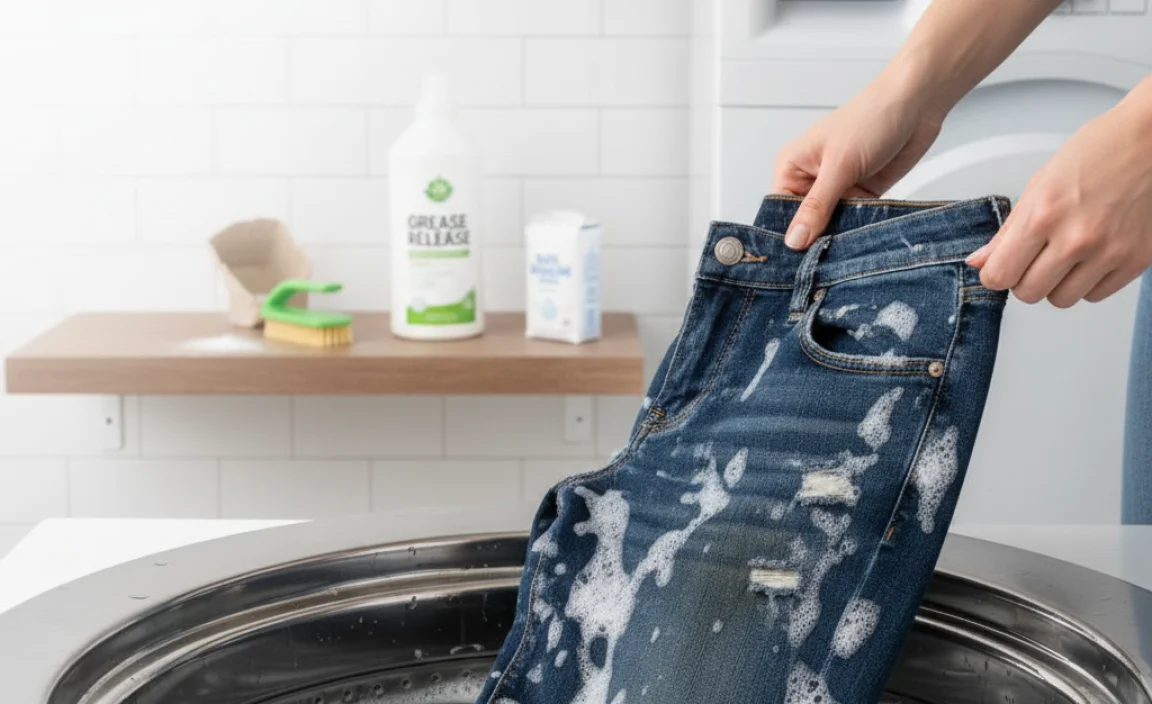
After pre-treating, it’s time to get your jeans into the washing machine. How you wash them is just as important as the pre-treatment steps.
Step 4: Wash in the Hottest Water Safe for Your Jeans
Wash your jeans using your regular laundry detergent. The key here is to use the hottest water setting that is safe for your denim. Hot water is more effective at breaking down and lifting grease than cold water.
Check Your Care Label:
Always check the care label inside your jeans for washing instructions. Most denim can handle warm or hot water, but some delicate washes or blends might require cooler temperatures. If in doubt, opt for warm water.
Add your usual detergent. For extra stain-fighting power, you can add a laundry booster or a stain remover product that is safe for colors. You can learn more about fabric care guidelines from organizations like the Federal Trade Commission (FTC), which provides consumer advice on garment care labeling.
Step 5: Inspect Before Drying!
This is a critical step. After the wash cycle is complete, but BEFORE you put your jeans in the dryer, inspect the stained area carefully. The heat from a dryer will set any remaining oil stain, making it permanent.
- Check the spot in good light.
- If the stain is still visible, do NOT put the jeans in the dryer. Repeat the pre-treatment and washing steps.
If the stain looks gone, you can proceed to drying.
Step 6: Air Dry or Tumble Dry
Once you are confident the stain has been removed, you can dry your jeans. For the first time after treating a stain, air-drying can be a good idea. This allows you to do one final check for the stain once the fabric is dry. If you used the dryer, use a medium heat setting.
If you performed the steps correctly, the stain should be gone. If, by chance, a faint mark persists after air-drying, you can repeat the pre-treatment and washing steps.
Dealing with Stubborn and Set-In Stains
Sometimes, olive oil stains aren’t discovered immediately, or they might have gone through the dryer once or twice. These set-in stains require a bit more effort but are often still salvageable.
Option 1: Enzyme-Based Cleaners
Enzyme cleaners work by breaking down organic matter, including oils and fats. You can find these in many laundry stain removers. Look for products that specify they work on grease or protein stains.
How to Use:
- Apply the enzyme cleaner directly to the stain according to the product’s instructions.
- Let it sit for the recommended time (this can range from a few minutes to several hours, depending on the product).
- Wash the jeans as usual in the hottest water safe for the fabric.
- Inspect before drying.
Option 2: Rubbing Alcohol (Isopropyl Alcohol)
Rubbing alcohol can act as a solvent for oil and grease. It evaporates quickly and can help lift the stain from the denim.
How to Use:
- Pour a small amount of rubbing alcohol onto a clean white cloth or cotton ball.
- Gently dab the stain with the alcohol-soaked cloth. Work from the outside of the stain inward to prevent spreading.
- You should see the oil lifting onto the cloth. Continue dabbing with a clean section of the cloth until no more oil transfers.
- Rinse the area with cool water.
- Pre-treat with a grease-cutting dish soap (Step 3).
- Wash as usual (Step 4).
- Inspect before drying (Step 5).
Always test rubbing alcohol on an inconspicuous spot of your jeans first to ensure it doesn’t cause discoloration, especially on darker or colored denim. You can find more information on fabric cleaning and stain removal from resources like The American Cleaning Institute.
Option 3: White Vinegar Soak
White vinegar’s acidity can help break down greasy residues. It’s a natural cleaner that can be effective for oil stains.
How to Use for a Soak:
- Mix one part white vinegar with two parts water in a basin or sink.
- Submerge the stained part of the jeans in the solution.
- Let it soak for 30 minutes to an hour.
- Gently rub the stained area together.
- Rinse the area with cool water.
- Pre-treat with a grease-cutting dish soap (Step 3).
- Wash as usual (Step 4).
- Inspect before drying (Step 5).
What NOT to Do When Removing Olive Oil Stains
Certain actions can inadvertently make an olive oil stain worse or harder to remove. Be mindful of these common mistakes:
| Mistake | Why it’s a Problem | What to Do Instead |
|---|---|---|
| Rubbing the stain | Pushes oil deeper into fibers and spreads the stain. | Blot gently with a clean cloth or paper towel. |
| Using only water immediately | Oil and water don’t mix; water can spread the oil. | Blot excess oil first, then use an absorbent powder. |
| Drying jeans before stain is gone | Heat from the dryer sets the oil stain permanently. | Always inspect jeans for stains before drying and air dry if in doubt. |
| Using harsh chemicals without testing | Can bleach or damage the denim fabric, especially colored jeans. | Test any new cleaner on an inconspicuous area first. |
FAQs About Removing Olive Oil Stains from Jeans
Q1: How quickly do I need to treat an olive oil stain on jeans?
The sooner, the better! Fresh stains are much easier to remove than old or set-in ones. Aim to blot and apply an absorbent powder within an hour of the spill.
Q2: Can I use baby powder to remove olive oil stains?
Yes, baby powder (which is usually talcum powder) can work similarly to cornstarch or baking soda. It’s designed to absorb moisture and can help draw out oil. Apply a generous amount, let it sit, and brush off.
Q3: What if the stain is on a dark pair of jeans?
The methods generally remain the same for dark jeans, but be extra cautious when using any cleaning agents. Always test on an inconspicuous area first to ensure no discoloration occurs. Dish soap and baking soda are usually safe bets.
Q4: Can I use mayonnaise or butter to remove olive oil stains?
No, this is a common misconception. While mayonnaise and butter are oily, they are additional sources of grease and will only make the stain worse. Stick to absorbent powders and degreasers.
Q5: How many times do I need to wash my jeans to remove the stain?
For fresh stains, one or two washes after proper pre-treatment is usually sufficient. For set-in stains, you might need to repeat the pre-treatment and washing process multiple times, using different degreasing methods if necessary. Patience is key.
Q6: Is it safe to use bleach on olive oil stains on jeans?
Only use bleach on white or bleach-safe colored jeans and always check the garment’s care label. For most denim, especially colored or dark washes, bleach is too harsh and can cause permanent damage or discoloration. Avoid bleach unless specifically instructed by the care label.
Conclusion: Keep Calm and Denim On
Dealing with an olive oil stain on your favorite jeans might seem like a disaster, but it’s a manageable laundry challenge. By acting quickly to blot and absorb, then strategically using household degreasers like dish soap, you can effectively lift the oily residue. Remember the golden rule: never dry your jeans if any trace of the stain remains. Repeating the pre-treatment and wash cycle is always a better option than setting the stain permanently.
With these proven methods, you’re well-equipped to handle olive oil spills and keep your denim looking its best. So, next time an oily mishap occurs, don’t fret. Grab your baking soda, reach for that dish soap, and follow these steps for spotless jeans. Happy laundering!


